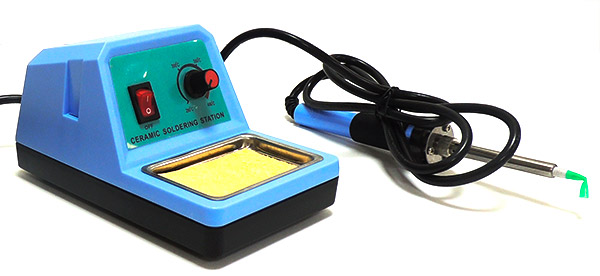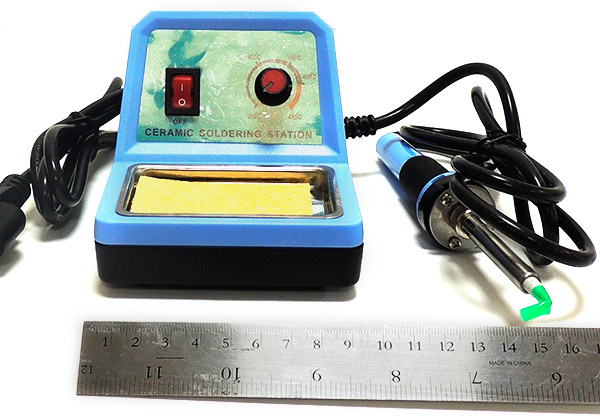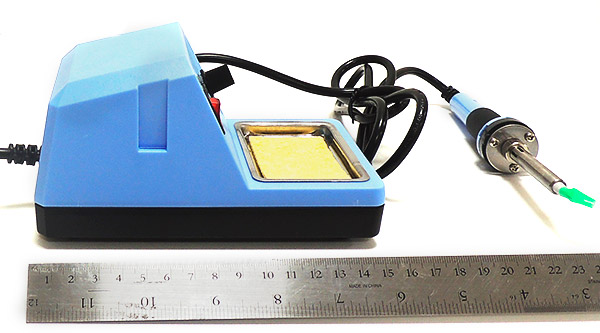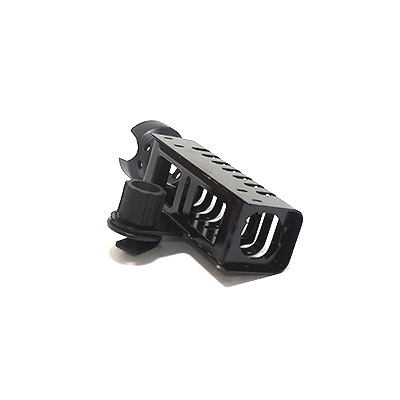AKTAKOM ASE-1112 Temperature controlled soldering station is used in the fields of electronic research, teaching and production, especially in the repairing and soldering on the electronic appliances and communication equipment.
AKTAKOM ASE-1112 soldering station (analog of ZD-932) provides 1 mounting channel and analog temperature control.
Specifications
- Channel: 1 assembling channel
- Analog control
- Max. station power: 48W
- Temperature range: 302°F - 842°F / 150°C - 450°C
- Max. power of the soldering iron: 48W
- Ceramic heating element
Safety instructions
Take care of yourself!
- Please read user manual carefully before using the instrument.
- Do not use the device if there is visible damage.
- Repair and maintenance of the device can be done only by a qualified specialist of the service center.
- Before connecting the instrument to the electrical network, observe all known precautions, and make sure that the grounding system is to avoid electric shock.
- Use only those accessories that are intended for use with this device.
- While working, do not touch the metal parts near the tip of the soldering iron.
- After completion of the work, it is necessary to install the soldering gun in the regular holder of the soldering gun.
Frequently Asked Questions
What are the differences between hot air and soldering iron rework?
Why is my solder not sticking to the pad or component?
What is the difference between a soldering iron and a soldering station?
What is an Aktakom soldering station used for?
How to care and use of the soldering tip?
Why a «de-tinned» tip fails to work?
How to clean and maintain the soldering tip?
How do I choose the right soldering temperature?
What are the differences between hot air and soldering iron rework?
|
Soldering iron: Direct contact, ideal for through-hole and simple SMD soldering.
Hot air gun: Non-contact, perfect for SMD component removal, IC reflow, and repairs on dense boards.
Up
|
Why is my solder not sticking to the pad or component?
|
Common causes:
-
Tip temperature too low or oxidized
-
Dirty pad or component leads
-
Using wrong flux type or insufficient solder
- Lead-free solder requires slightly higher temperature
Up
|
What is the difference between a soldering iron and a soldering station?
|
|
A soldering iron is a standalone tool with a fixed power and basic control.
A soldering station provides adjustable temperature, stable power delivery, interchangeable tips, and often includes additional functions like sleep mode or rework tools.
Up
|
What is an Aktakom soldering station used for?
|
|
Aktakom soldering stations are designed for precision electronic soldering and repair work.
They allow users to assemble, rework, and desolder electronic components on circuit boards safely and efficiently, with accurate temperature control and ESD-safe performance.
Up
|
How to care and use of the soldering tip?
|
Tip’s temperature High soldering temperatures can degrade the tip. Use the lowest possible soldering temperature. The excellent thermal recovery characteristics ensure efficient and effective soldering event at low temperatures. This also protects the sensitive components from thermal damage. Cleaning Clean the tip regularly with a cleaning sponge, as oxides and carbides from the solder and flux can form impurities on the tip. These impurities can result in defective joints or reduce the tip's heat conductivity. When using the soldering iron continuously, be sure to loosen the tip and remove all oxides least once a week. This helps prevent reduction of the tip temperature. When not in use Never leave the soldering iron sitting at high temperature for long periods of time, as the tip's solder plating will be covered with oxide, which can greatly reduce the tip's heat conductivity. After use Wipe the tip and coat it with fresh solder. This helps to prevent tip oxidation.
Up
|
Why a «de-tinned» tip fails to work?
|
A de-tinned tip is one which cannot wet with solder. This exposes the plating to oxidation and degrades the heat transfer efficiency of the tip.
The de-tinning is caused by:
1) Failure to keep the tip covered with fresh solder while not in use.
2) High tip temperatures.
3) Insufficient melting in soldering operations.
4) Wiping the tip on dirty or dry sponges and rags (Always use a clean, wet, industrial grade, sulfur-free sponge).
5) Impurities in the solder, iron plating, or on the surfaces to be soldered.
Up
|
How to clean and maintain the soldering tip?
|
Caution! Never file the tip to remove oxide. Avoid using abrasive materials.
- Set the temperature to 250°C.
- When the temperature stabilizes, clean the tip with the cleaning sponge and check the condition of the tip.
- If there is black oxide on the solder-plated portion of the tip, apply new solder (containing flux) and wipe the tip on the cleaning sponge. Repeat until the oxide is completely removed. Coat with new solder. The solder protects the tip from oxidation and prolongs the life of the tip.
- If the tip becomes pitted, blackened, or won’t hold solder, replace it with a new one.
Up
|
How do I choose the right soldering temperature?
|
600 - 650°F (316 - 343°C) is a good place to start for lead-based solder and 650 - 700°F (343 - 371°C) for lead-free solder.
Note: if clots form, the temperature is too low. Use the lowest temperature that melts the solder efficiently — excessive heat can damage components or PCB pads.
Up
|
La estación de soldadura con control de temperatura ASE-1112 se utiliza en los campos de la investigación, enseñanza y producción electrónica, especialmente en la reparación y soldadura de aparatos electrónicos y equipos de comunicación.
1 canal de montaje. Control analógico. Rango de temperatura: 150 °C - 450 °C Máx. Potencia de soldadura 48 W Calentador cerámico. Consumo de energía máximo de 48 vatios.
Back to the section
|
|













